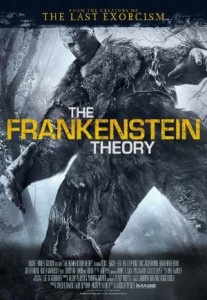
Currently Available via OnDemand Platforms
Director: Andrew Weiner
MPAA Rating: NR
Film Pulse Score: 2.5/10
The Frankenstein Theory is the latest in a line of movies made as if they were documentaries. It is being marketed as a horror film, but there is little to nothing here that fits in that genre save a few scenes at the end. It is an example of an interesting idea that is badly executed. The concept is that the story of Frankenstein and his monster are not fictional. Instead, Mary Shelley based her novel on real events. A documentary crew follows a young man who is convinced that not only does the monster exist, but that the man-made entity was created by one of his ancestors. It is a nice thought and the 2.5 “points” are more-or-less just for the concept; I must give the execution zero points on our 10-point scale.
Professor Jonathan Venkenheim (Kris Lemche) decides to travel to the Arctic Circle where he believes the monster continues to exist. His old friend, Vicky (Christine Lakin), is a documentary filmmaker who agrees to follow Venkenhein on his journey and film the trip. Her crew members (Brian Henderson and Eric Zuckerman) add color and humor to the film. One of their first stops involves interviewing an eye-witness (Joe Egender). He tells of his encounter and even has a sketch of what he saw. When the group gets to Canada, they hire a guide (Timothy V. Murphy) to take them into the far northern wilderness where Jonathan is convinced the monster lives. He is basing this not only on Shelley’s novel but on migratory patterns of predators. He maps out the monster’s likely territory which includes mapping several locations where people have gone missing without explanation. Apparently, this is enough evidence for Jonathan to decide a 200-year-old reanimated corpse (well, corpses sewn together) is still “alive.”
Essentially, Weiner has simply remade The Blair Witch Project and/or filmed a feature-length version of the Animal Planet’s “Finding Bigfoot” series. Almost 15 years later, filmmakers are still trying to recreate Blair Witch’s premise and its incredible commercial success. We must remember, however, that Blair Witch was successful largely because (a) it was genuinely well made, (b) it was incredibly creepy and even claustrophobic even though the events take place outside, and (c) it was original in both concept and execution. No film made along the same lines has been as successful with the exception of the first Paranormal Activity. Both of those movies were actually scary. The Frankenstein Theory just is not, not even when it intensifies as the group sets up camp in the wilderness with a monster possibly tracking them. Just like Blair Witch, most of the purportedly scary moments happen off screen. The group and we viewers hear awful cries in the dark that are unique; they are not wolves or any other animal the guide has ever heard before.
Since I do not write reviews containing spoilers, I will leave out what ultimately happens to the group in the wilderness. Maybe the monster exists. Maybe it is stalking the group. Maybe it does not abide having its territory encroached upon. Maybe they all wind up dead in a foolish attempt to capture the monster on camera. The one thing that is not a “maybe” is that Weiner’s effort falls incredibly flat. I enjoy horror movies and I even like the “found footage” or “documentarian” style of horror films, but most of these movies are not worth seeing and are quite unrewarding. The Frankenstein Theory is in this ever-growing category of Blair Witch remakes that fails to scare, engross, or capture and hold my attention.







Love the comment –“filmed a feature-length version of the Animal Planet’s “Finding Bigfoot” series.” Snarky as ever, Todd!